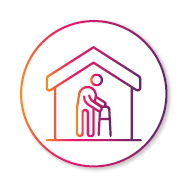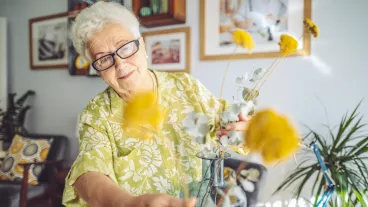Social isolation: Factors, dynamics and effects of isolation for older people
February 2024
Download Research snapshot
What is social isolation?

Social isolation involves an objective lack of connection and interaction with social networks, which can include family, friends and community. Social isolation can have multiple negative effects on wellbeing for older people. Among the poor health and wellbeing outcomes associated with social isolation are:
- decreased quality of life
- functional decline
- decline in cognitive health and function
- poor mental health
- poor physical health
- increased risk of mortality
- low capacity for physical activity and problems with maintaining self-care.
Social isolation can give rise to subjective experiences of loneliness. Feelings of loneliness can be shaped by experiences of social isolation. Loneliness is an individual's own view of the quality of and satisfaction with their social connectedness, supports and interactions.
Sources: Beridze et al., 2020; Chan et al., 2015; Freak-Poli et al., 2021; Hajek et al., 2021; Hu et al., 2021; Machielse & Duyndam, 2020; Saito et al., 2021; Santini et al., 2016; Schrempft et al., 2019; Shankar et al., 2013.
What factors give rise to social isolation?
Social isolation can arise from a range of factors and these include:

How is social isolation experienced by older people?
Tension between isolation and independence

Our desktop review highlighted a problematic tension between maintaining independence (e.g. through undertaking household management and self-care) and the need for connection with others and support seeking for some older people (Machielse & Duyndam, 2020; Plath, 2008). Independence is important; however, it can come at the expense of some forms of connection that might also support the wellbeing of older people. Some participants spoke about a 'loss of independence' as being particularly challenging and confronting for older people:
The loss of independence, and the loss of health, health is another huge, big thing, like their mobility, which impacts the mental health, so it's like vice versa, and the fear of: What will happen? How? How will it happen? The fear of [the] unknown. (P05, non-government sector, metropolitan)
Some service providers suggested that this fear of losing independence drove some older people to avoid accessing residential aged care services:
I think the main thing is that going in a [aged care] facility is just another way for them [older people] to feel that death is a reality and all of that … they feel that they go to the facility and they're going to go in there and die. (P05, non-government sector, metropolitan)
Gendered dynamics of social isolation

Previous research has identified that older men are more likely to report unsupportive relationships and higher levels of community disengagement than older women. For men, living alone has been found to be associated with higher social exclusion. On the other hand, for women, living alone was found to be associated with increased community engagement (Paine et al., 2022). Echoing this research, some of the service providers suggested that older women were more likely to engage in social activities than men. One observed:
I just think [women] are a bit more proactive and a little bit more aware of the need to have those kinds of friend networks. (P02, not-for-profit community sector, metropolitan)
Another reflected on the reach of programs targeting men:
There's things like the Men's Sheds. They're probably great for people who've hammered and tinkered with tools. But when you think overall, the participation rates [are] that low, that's not good enough as a sector. (P08, public sector, metropolitan)
Challenges to recognising social isolation
Social isolation might not always be recognised as a problem by those who experience it and may be better recognised by others, including carers. Some service providers observed that some older people who were socially isolated did not realise that their isolation was an issue. These circumstances impacted on their cognition, wellbeing and on those providing care to them:
People who are socially isolated, they don't realise they're socially isolated. So, they don't see it as an issue … so people living with dementia who are socially isolated, their caregivers are the ones who do notice it because they're not getting a break … so many times I've tried to link people in with going to a social support group just to try to improve their mood and their outlook on life. They go, 'I'm not interested in it.' (P01, public sector, rural)
Service providers also drew attention to carers as a group of older people at particular risk of social isolation:
People engaged in care [are] extremely likely to be socially isolated … what we found with all the carers is very often they're caring for a partner who's older themselves … the problem arises when either that relationship doesn't provide that connectedness anymore because of conditions or because of deteriorating circumstances, or when that relationship ends. (P03_P5, community sector, metropolitan, regional and rural)
How do service providers identify social isolation and support access to services?
Identifying socially isolated older people can be challenging, given that they are less visible in the community and some older people do not consider themselves to be isolated. However, health practitioners play a particularly important role in identifying older people in need of support and linking older people into support services (Pettigrew et al., 2014). Service providers indicated that engagement in the My Aged Care platform and referral to other supports from My Aged Care was a key way in which socially isolated individuals were identified:
We do a comprehensive assessment to come onto our service. We usually get the referral with My Aged Care … but we also do an assessment. So, we go and visit them face to face or they come here and … we actually do a care plan … which is person-centred, and we work out, you know, who they interact with in the community, their family support, all that information. And also, we do a social support assessment to see what they want to do that they are unable to do and what the barriers are to that, which could be transport, could be, you know, they don't feel comfortable with people. (P03_P2, community sector, metropolitan)
At the same time, challenges arose when older people found the line of questioning in some of the formal screening tools confronting. For example, the following participant recalled:
I personally have used the Personal Wellbeing Index and I found that being a bit confronting to some clients … it was very challenging using it because [you need] the skills to ask those questions, but you're not supposed to ask the questions in another way. (P03_P1, community sector, metropolitan)
These kinds of challenges were important considerations for service providers, and some reflected on informal ways of identifying social isolation, highlighting the importance of being visible in the community:
There's no screening tools. I think we just ask a lot of questions. So a lot of times we'll hold a meeting and the community … and the community comes to us and basically talks to us about what their needs are and we're able to identify [isolated older people]. (P06_P3, community sector, regional)
Summary
- Social isolation is associated with significant life events such as retirement or relocation, loss of a spouse or changing relationships with adult children.
- Social isolation can have a significant impact on the health and wellbeing of older people.
- Social isolation can be experienced in many different ways, including:
- tensions between maintaining independence and receiving support
- gendered experiences of social isolation
- challenges in recognising social isolation.
- These experiences indicate that social isolation is an issue that requires careful and tailored responses to meet the needs of individuals and groups.
- It would be valuable to structure supports so that they are flexible in design and are available around key life changing events.
About this study
Seniors Rights Service commissioned the Australian Institute of Family Studies (AIFS) to undertake an exploratory, qualitative study to examine the factors, dynamics and effects of isolation experienced by older people in New South Wales. The study was funded by the New NSW government and based on a desktop review and qualitative interviews with professionals.
This snapshot briefly summarises key findings from the desktop review of Australian and international literature relating to experiences of isolation among older people. It also provides relevant insights from individual and group interviews with 20 professionals who work with older people in a variety of settings.
Access the full report: Factors, dynamics and effects of isolation for older people: an exploratory study.
This report was commissioned by Seniors Rights Service and funded by the NSW government.
Get more information about the Senior Rights Service.
References
Beridze, G., Ayala, A., Ribeiro, O., Fernández-Mayoralas, G., Rodríguez-Blázquez, C., Rodríguez-Rodríguez, V. et al. (2020). Are loneliness and social isolation associated with quality of life in older adults? Insights from Northern and Southern Europe. International Journal of Environmental Research and Public Health, 17(8637).
Chan, A., Raman, P., Ma, S., & Malhotra, R. (2015). Loneliness and all-cause mortality in community-dwelling elderly Singaporeans. Demographic Research, 32, 1361-1382.
Freak-Poli, R., Ryan, J., Tran, T., Owen, A., McHugh Power, J., Berk, M. et al. (2021). Social isolation, social support and loneliness as independent concepts, and their relationship with health-related quality of life among older women. Aging & Mental Health, 1-10.
Hajek, A., Brettschneider, C., Mallon, T., Kaduszkiewicz, H., Oey, A., Wiese, B. et al. (2021). Social support and health-related quality of life among the oldest old: Longitudinal evidence from the multicenter prospective AgeCoDe-AgeQualiDe study. Quality of Life Research: An International Journal of Quality of Life Aspects of Treatment, Care and Rehabilitation.
Hu, J., Fitzgerald, S. M., Owen, A. J., Ryan, J., Joyce, J., Chowdhury, E. et al. (2021). Social isolation, social support, loneliness and cardiovascular disease risk factors: A cross-sectional study among older adults. International Journal of Geriatric Psychiatry, 36(11), 1795-1809.
Machielse, A., & Duyndam, J. (2020). Strategies of socially isolated older adults: Mechanisms of emergence and persistence. Journal of Aging Studies, 53, 100852.
Paine, N., Rachele, J. N., & Turrell, G. (2022). Sociodemographic characteristics and social exclusion among the oldest old. Australasian Journal on Ageing, 41(4), 563-572.
Pettigrew, S., Donovan, R., Boldy, D., & Newton, R. (2014). Older people's perceived causes of and strategies for dealing with social isolation. Aging & Mental Health, 18(7), 914-920.
Plath, D. (2008). Independence in old age: The route to social exclusion? British Journal of Social Work, 38(7), 1353-1369.
Saito, M., Aida, J., Cable, N., Zaninotto, P., Ikeda, T., Tsuji, T. et al. (2021). Cross-national comparison of social isolation and mortality among older adults: A 10-year follow-up study in Japan and England. Geriatrics & Gerontology International, 21(2), 209-214.
Santini, Z., Fiori, K. L., Tyrovolas, S., Haro, J. M., Feeney, J., & Koyanagi, A. (2016). Structure and function of social networks, loneliness, and their association with mental disorders among older men and women in Ireland: A prospective community based study. European Psychiatry, 33(Supplement), S178-S179.
Schrempft, S., Jackowska, M., Hamer, M., & Steptoe, A. (2019). Associations between social isolation, loneliness, and objective physical activity in older men and women. BMC Public Health, 19(1), 1-10.
Shankar, A., Hamer, M., McMunn, A., & Steptoe, A. (2013). Social isolation and loneliness: Relationships with cognitive function during 4 years of follow-up in the English Longitudinal Study of Ageing. Psychosomatic Medicine, 75(2), 161-170.
Media releases
© GettyImages/Dean Mitchell
Stevens, E., Carson, R., & Wall, L. (2023). Social isolation: Factors, dynamics and effects of isolation for older people. Melbourne: Australian Institute of Family Studies.
Download Research snapshot
Related publications

Factors, dynamics and effects of isolation for older people…
This report sets out the findings of the Factors, Dynamics and Effects of Isolation for Older People: An Exploratory…
Read more
Factors, dynamics and effects of isolation for older people
This snapshot discusses what factors give rise to isolation and how it is experienced by older people.
Read more
Geographical isolation: Factors, dynamics and effects of…
This snapshot briefly summarises the barriers to accessing services and supports for geographically isolated older…
Read more